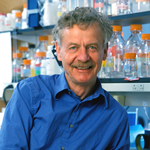
A revolution has been taking place in biology and medicine, based on exciting new techniques to help scientists understand life at its basic genetic level, promising new advances in the treatment and prevention of disease. For four decades, Rudolf Jaenisch has been a leader in developing new ways to study living cells through the complementary disciplines of transgenics and epigenetics. Nearly 60 years ago, when the structure and importance of DNA were first realized, scientists believed that heritable genetic changes arose only from changes in the sequence of the DNA helix. But subsequent research demonstrated that other mechanisms can produce heritable changes in genetic expression and cellular phenotypes without causing mutations in the DNA sequence. These mechanisms are vital for cell differentiation and growth, but when gone astray, they can also give rise to a host of disease processes. The study and manipulation of these mechanisms is called epigenetics, a field Rudolf Jaenisch has been part of since its conception.
After beginning as a medical student at the University of Munich, Jaenisch switched to molecular biology research and, after obtaining his M.D., came to the U.S. in 1970 as a post-doctoral fellow at Princeton University, working with geneticist Arnold Levine on cancer studies. A self-described "crazy experiment" not only set him on his path to become one of the founders of epigenetics, but resulted in the development of a vital new experimental technique. Jaenisch was studying the SV40 tumor virus and found that when he injected the virus into adult mice, they all contracted sarcoma, a type of cancer that attacks only supporting tissue such as bone or muscle. Why only that form of cancer rather than another? Either the SV40 wasn't capable of infecting other types of cells, or those cells were somehow "turning off" the virus. To find out, Jaenisch decided to try introducing SV40 into mice at the embryonic stage, where it could affect all the cells equally, before they developed into different types. But the mice grew up perfectly healthy, with no signs of SV40 infection. Had the embryonic injection "taken?"
When Jaenisch moved to the Salk Institute, he was able to answer the question. By using radioactive DNA markers to probe for retroviruses, Jaenisch confirmed that the SV40 had indeed been incorporated into the mouse genome. He had created the first "transgenic" mice, in which foreign DNA was successfully introduced into the embryonic DNA. In later experiments involving a leukemia virus, he confirmed that foreign DNA injected into embryos was inherited by future generations. But Jaenisch's original question remained unresolved: why didn't the mice injected with SV40 as embryos develop cancer, unlike adults exposed later in life? This question led to his discovery of the importance of DNA methylation, in which methyltransferase enzymes control the expression of particular genes. Jaenisch found that it was possible to silence or activate the expression of particular genes by knocking out those that affect methyltransferase. It was these epigenetic mechanisms that determined whether the effects of a retrovirus would be expressed. Jaenisch extended his work in these areas to establish the role of DNA methylation in cell differentiation and development, the development of cancer and other diseases.
Rudolf Jaenisch's research has promise to forge new paths in the treatment and cures for some of humanity's deadliest diseases. Although as a young M.D. he chose to become a researcher rather than a clinician, his discoveries nonetheless promise to touch and perhaps save the lives of countless individuals.
Information as of April 2013

